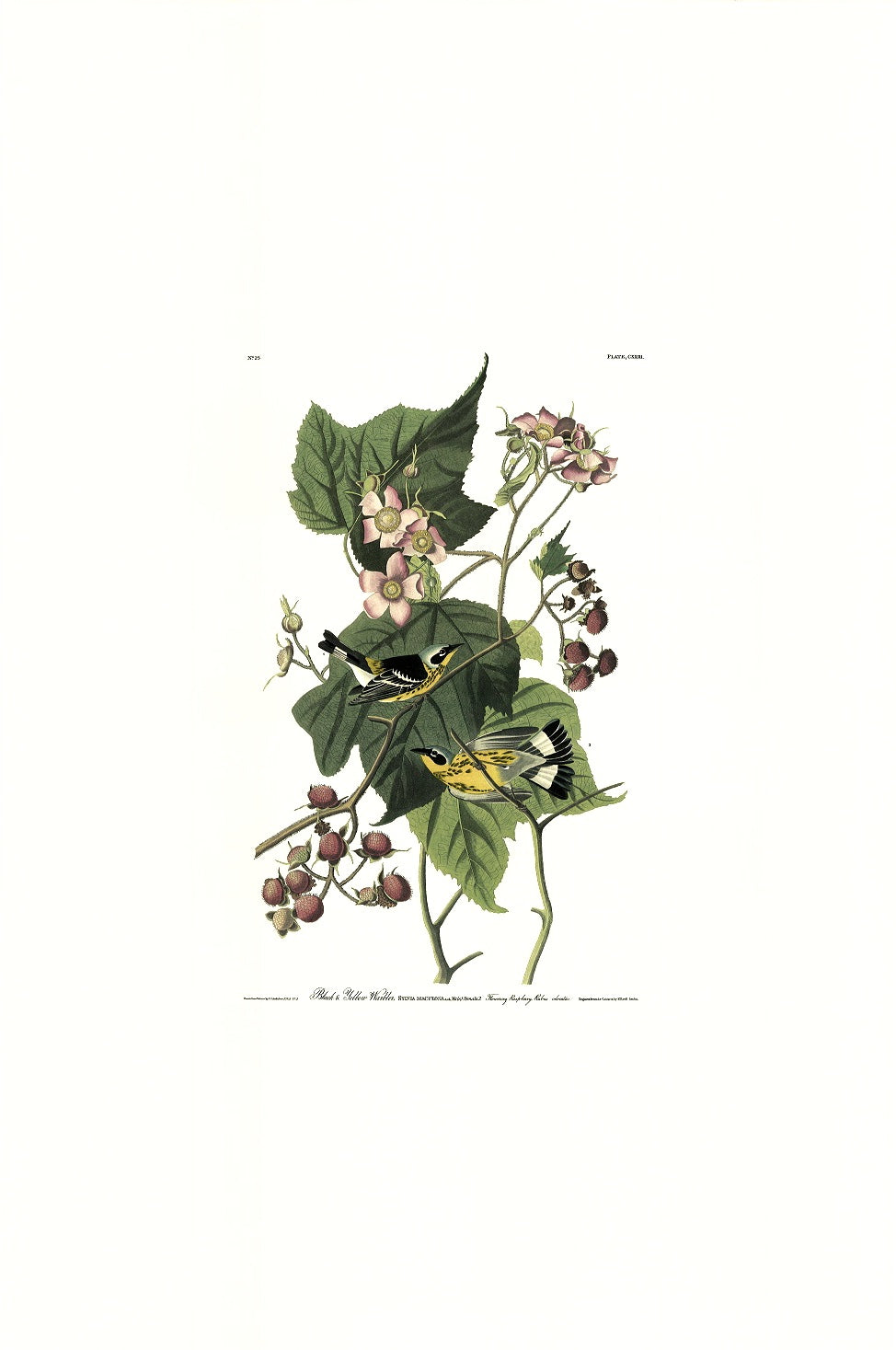Black & Yellow Warbler
Black & Yellow Warbler
John James Audubon’s Birds of America
Princeton Audubon Double Elephant Edition of 1500.
26 1/4 x 39 1/4; Condition: Mint
Nature is never out of style, so ... Feather your nest!
Thank you for visiting Princeton Audubon!
“Of all the full-size facsimiles of Audubon's prints, those from Princeton Audubon Ltd. come the closest in appearance and quality to the originals. Combining this with their very reasonable cost makes Princeton Audubon facsimiles winners for those looking to acquire some of the most dramatic American natural history images ever produced." - Chris Lane, Philadelphia Print Shop West, appraiser on Antiques Roadshow.
Of our prints, William Steiner, author of Audubon Prints: A Collector’s Guide To Every Edition wrote, “True prints, true colors, incredible detail. Princetons are simply the finest Audubon facsimiles ever made!”
We purchased the actual antique originals in order to accurately produce this award-winning edition, giving you a connection to Audubon’s original work. Read more ...
In order to create this spectacular print, we needed to purchase the actual original. Measuring more than two feet by three feet, the birds are the same size as in life.
Princetons began with the purchase of the actual originals which were physically used in the production process. A giant camera with film the same size as the print took a direct-capture picture of the original, and this exact image was transferred directly to the metal printing plates. There are no other Audubon facsimiles which match the quality of Princeton prints.
Our prints have this embossed seal at the lower right of the paper ...

... and are pencil-numbered in the lower left under the printed script.
Here are the printing specifications ...
Princeton Audubon Double Elephant Edition •Double elephant (life size - 26 1/4 x 39 1/4) •Limited edition of 1500. •Pencil-numbered and embossed with the Princeton Audubon Limited seal. •Up to 11 color plates used. •Specially developed fade-proof inks. Absolute color fidelity to the actual original. •Printed on a 300 line. •Very heavy archival paper which is recommended by the Library of Congress for archives and is specially toned to match the actual color of the antique originals. •Registered to purchaser. •As permanently displayed at The Royal Society of London, to which Audubon belonged as a Fellow.
About the image itself ...
According to Roger Tory Peterson, "Audubon drew this immature magnolia warbler in Louisiana on October 20, 1821, when it was in its autumnal migration." The original for the plate was a painting made in 1829 and inscribed "Great Pine Swamp, Aug-12th." "Black and Yellow Warbler," the name formerly applied to the magnolia warbler, was most descriptive of its color, but had the disadvantage of being equally descriptive of several other warblers. Thus the change to magnolia warbler. In its movements it has a trick of partly spreading its tail, thereby showing the characteristic white band crossing midway.
Black & Yellow Warbler
John James Audubon’s Birds of America
Princeton Audubon Double Elephant Edition of 1500.
26 1/4 x 39 1/4; Condition: Mint
Nature is never out of style, so ... Feather your nest!
Thank you for visiting Princeton Audubon!
“Of all the full-size facsimiles of Audubon's prints, those from Princeton Audubon Ltd. come the closest in appearance and quality to the originals. Combining this with their very reasonable cost makes Princeton Audubon facsimiles winners for those looking to acquire some of the most dramatic American natural history images ever produced." - Chris Lane, Philadelphia Print Shop West, appraiser on Antiques Roadshow.
Of our prints, William Steiner, author of Audubon Prints: A Collector’s Guide To Every Edition wrote, “True prints, true colors, incredible detail. Princetons are simply the finest Audubon facsimiles ever made!”
We purchased the actual antique originals in order to accurately produce this award-winning edition, giving you a connection to Audubon’s original work. Read more ...
In order to create this spectacular print, we needed to purchase the actual original. Measuring more than two feet by three feet, the birds are the same size as in life.
Princetons began with the purchase of the actual originals which were physically used in the production process. A giant camera with film the same size as the print took a direct-capture picture of the original, and this exact image was transferred directly to the metal printing plates. There are no other Audubon facsimiles which match the quality of Princeton prints.
Our prints have this embossed seal at the lower right of the paper ...

... and are pencil-numbered in the lower left under the printed script.
Here are the printing specifications ...
Princeton Audubon Double Elephant Edition •Double elephant (life size - 26 1/4 x 39 1/4) •Limited edition of 1500. •Pencil-numbered and embossed with the Princeton Audubon Limited seal. •Up to 11 color plates used. •Specially developed fade-proof inks. Absolute color fidelity to the actual original. •Printed on a 300 line. •Very heavy archival paper which is recommended by the Library of Congress for archives and is specially toned to match the actual color of the antique originals. •Registered to purchaser. •As permanently displayed at The Royal Society of London, to which Audubon belonged as a Fellow.
About the image itself ...
According to Roger Tory Peterson, "Audubon drew this immature magnolia warbler in Louisiana on October 20, 1821, when it was in its autumnal migration." The original for the plate was a painting made in 1829 and inscribed "Great Pine Swamp, Aug-12th." "Black and Yellow Warbler," the name formerly applied to the magnolia warbler, was most descriptive of its color, but had the disadvantage of being equally descriptive of several other warblers. Thus the change to magnolia warbler. In its movements it has a trick of partly spreading its tail, thereby showing the characteristic white band crossing midway.

